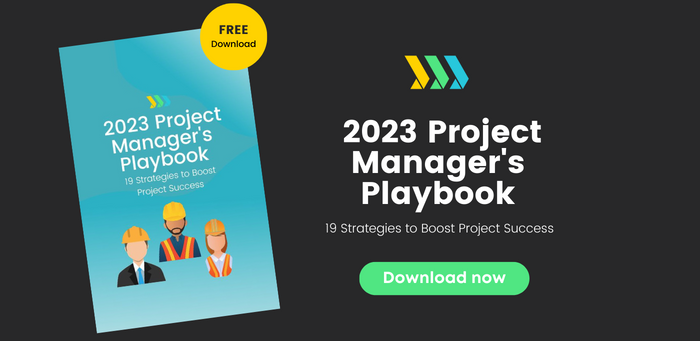Are you trying to find a more proactive approach to construction defect management?
Perhaps you are sick of constantly putting out fires, and you want to adopt a solution that will prevent them from occurring in the first place.
If you are keen to stop working reactively and start working proactively, you’ve come to the right place.
In this article, we’ll take a deeper look at traditional methods of defect management and identify how these processes can be improved to bring greater success in projects.
What is Defect Management?
Defect management plays an essential role in the quality management of the construction industry. Any construction management team should undertake defect management throughout the construction process to lessen the number of defects and to ensure the project goes as smoothly as possible.
A construction defect is any aspect of a project that does not meet the required material quality, design, or workmanship.
Construction defect management attempts to put measures in place to prevent any defects from occurring or rectify them as quickly as possible when they do occur.
Top-level defect management requires excellent quality control inspections, practices, and technology to log information about defects to establish the potential knock-on effect.
This additional technology allows project managers to evaluate data and resolve defects quickly and prevent them from occurring again in the future.
How do people typically approach defect management?
When it comes to construction defect management, most projects use the following:
- Site walks
- Defect tools
Site walks
The most traditional approach to managing defects is through site walks, where site managers attempt to scope the site for defects.
To achieve effective defect management through site walks, you have to spend hours walking the site each morning, meeting with the trades team for updates, and typing up any notes.
It’s estimated that construction managers typically spend 16 hours per week doing site walks and then an additional 10 hours to process this information.
Defects can occur at any time on any day, which means you must complete site walks every morning and afternoon to ensure you are up to speed with everything that is occurring on your job site. Even then, you can miss valuable information.
Defect tools
The other approach that project managers take is to use defect management tools, such as PlanGrid, ViewPoint Field View, Snag-r, and Planradar.
These solutions help you digitise the construction defect management process. You put a pin on a plan to show where a defect has occurred and send this directly to your subcontractors. They get a notification and are responsible for fixing the issue. They can then report back in the tool once it has been resolved.
Defect tools can be used as an alternative to spreadsheets and manual paper-based processes to help document defects more efficiently.
The problem with the traditional way of approaching defect management
Silos
When talking about site walks and defect tools, it is commonplace that project managers refer to this as part of their workflow management, but that isn't technically true.
After all, you can't call a task workflow management if there isn't workflow! Instead, this process typically starts with the issue occurring and then creating a workflow for each defect and reporting each defect in its separate workflow.
By tackling defects in this manner, you treat each defect in isolation without factoring in how these defects relate to each other and the wider project when in truth, all defects are highly interconnected.
This approach leads to siloes and the project can very quickly veer off track.
Want to break down silos and improve communication on projects? Read this article: Communication Management in Construction.
Reactive Instead of Proactive
While the standard approaches to defect management help to record defects, they don't help you to understand why the defects occurred in the first place.
This is largely down to the disconnected approach. Because each defect is treated in its own silo and there is little connectivity with the wider project as a whole, it’s impossible to truly get to the root cause of defects.
This leaves you simply reacting to issues rather than proactively taking action to prevent them. The traditional approaches to defect management simply document the inevitable car crash on a project, they don’t help to stop the car crash from happening in the first place.
Defect management as an afterthought vs. in the moment
When using traditional tools, you might not be aware of a defect for some time, as there is no real-time information available. That often means defects get missed for some time, and why they are finally discovered, chances are the impact is much more severe.
You don't know about a defect for some time. There is no real-time information, so often defects may be spotted later, which means that the severity of the issue is often worse.
Lack of collaboration
Finally, traditional defect management systems do not foster collaboration and instead focus on following a hierarchical process.
This process forces project managers to spend precious time checking trade work defects rather than creating ownership and accountability, where all trades are responsible for preventing and reporting defects as they complete their work.
How to improve defect management
So it begs the question, what’s the better way to do construction defect management?
After working with some of the biggest players in the construction industry, we’ve found that those that are able to get control of their defects almost always follow the following principles:
1. Get to the root cause of defects. Understanding why the defects occur in the first place is essential to stop them from happening in the future.
- Understand how defects impact your wider project. The better you understand how the defects are connected to the rest of your project, the faster you’ll be able to respond to any defect that comes up. Speed on a project is essential and this knowledge will help improve decision-making under pressure.
- Address defects in real time. Defects should be identified and resolved on the job immediately after the work is carried out. This will allow you to rectify issues before they have a chance to become a bigger problem.
- Lean from your mistakes early on. Being able to identify mistakes sooner rather than later always puts you in good stead to progress faster with fewer issues
- Make defect management collaborative. If defect management is only down to one person on a project, chances are, issues will get missed and small defects will become big ones. Taking a collaborative approach where everyone is responsible for defect management will help you spot, fix and learn from defects more effectively.
Proactive construction defect management with Sablono
The Sablono platform was created to help you achieve the five best practices above with ease. It allows you to predefine your defect management in advance which offers you a holistic and connected view of your project, and allows you to identify potential knock-on effects before they occur.
Sablono was specifically created to offer project managers like you a proactive and effective approach to defect management, allowing you to fix, prevent and learn from defects.
What sets Sablono apart from its competitors is the ability to locate a defect within a workflow. This is better than simply locating it in a plan because you can learn much more from it. You can immediately see the defect's impact on the overall project.
Having this knowledge allows you to make key decisions like can the following trades still come in and execute their work or do you need to stop. It helps you answer questions like 'how severe is the issue?'.
With Sablono, a trade worker locates a defect in the process and logs in on the platform. They also enrich the bites with pictures or add text on top of a predefined defect template. Project managers can then quickly analyse them in a structured way and undertake root cause analysis.
Get to the root cause of defects
Sablono allows you to establish where a defect has occurred and WHY it went wrong. Many digital solutions will help you see when a defect has happened during the construction phase, but where Sablono really shines is that it helps you identify what leads to the defect in the first place. This helps you to learn from your mistakes and prevent defects from occurring in the future.
Immediately understand the impact of defects
Not only does Sablono allow you to establish the root cause of a construction defect, but it also allows you to immediately understand the impact that defect has on the rest of your project.
Real-time information at the most granular level is available to whoever needs it whenever they need it. Sablono shows you which trades are involved, which activities are impacted, and where the defect in question sits on your workflow.
All this information allows you to manage the defect as quickly as possible, removing the issue and updating the relevant teams and stakeholders on any potential changes to the original plan at the click of a button.
You can quickly see whether a defect will have a knock-on effect or not and use the Sablono platform to update all of the relevant teams by updating the overall project timeline.
Learn from mistakes early on in the construction process
As every project manager can test, construction projects tend to be under strict time and budget constraints. Chances are, you are constantly getting hassled by stakeholders on where the project is up to, whether it is on track, and whether it is on budget.
With tight deadlines to try to achieve, some of which often affect bonus payouts, defects constantly occurring can quickly knock a project off course.
With the Sablono software system, as defects are reported as each trade completes their work, you can learn from mistakes early and prevent them from occurring again.
Say goodbye to the days of mistakes and defects occurring throughout a project. Automated dashboards and reporting give unique insights into your project to help you understand what is truly happening on-site.
For example, if you are working on a residential project, and during the execution of level 1, you notice a pattern of defects, you can easily take action to prevent this as you move onto the other floors rather than continuing to make the same mistakes as the project progresses.
Turn defect management into a team effort
Proactive defect management must be a collaborative effort. The Sablono platform lets anyone record defects in real-time, significantly reducing the workload on project managers and ensuring defects are flagged and dealt with as quickly as possible.
Sharing information allows project managers to oversee the process of rectifying defects without having to drop everything they are doing to come and solve it themselves.
Sablono's construction quality assurance software helps you minimise defects, get to the root cause of quality issues and streamline your workflows to get it right first time.
Get a demo today to see how it can help you transform your defect management.



